
The province of Chieti is a province in the Abruzzo region of Italy. Its provincial capital is the city Chieti, which has a population of 50,770 inhabitants. The province has a total population of 387,649 inhabitants as of 2017 and spans an area of 2,599.58 square kilometres (1,003.70 sq mi). It is divided into 104 comuni (comune) and the provincial president is Mario Pupillo.
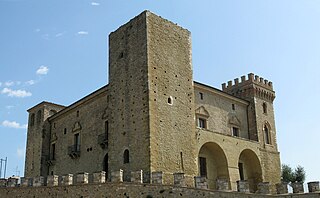
Crecchio is a comune and village in the province of Chieti, part of the Abruzzo region in central Italy. The village preserves its medieval aspect and is dominated by its castle.

Chieti is a city and comune (municipality) in Central Italy, 200 kilometres east by northeast of Rome. It is the capital of the province of Chieti in the Abruzzo region.

Lanciano is a town and comune in the province of Chieti, part of the Abruzzo region of central Italy. It has 36,304 inhabitants as of 2011. The town is known for the first recorded Catholic Eucharistic Miracle. Lanciano is located about 10 kilometres (6.2 mi) from the Adriatic Sea in an elevated spot.

Villa Santa Maria is a town and comune in the province of Chieti, in the region of Abruzzo of southern Italy.
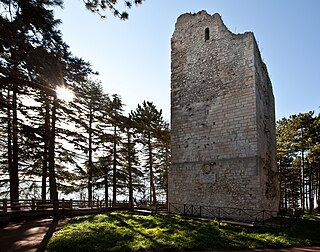
Guardiagrele is a town and comune in the province of Chieti, part of the Abruzzo region of central Italy. It is in the foothills of the Maiella mountain at an elevation of around 576 metres (1,890 ft). Its population numbers about 10,000.
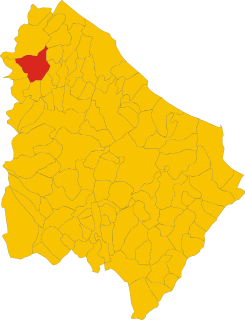
Bucchianico is a comune and town in the province of Chieti in the Abruzzo region of Italy.
Canosa Sannita is a comune and town in the province of Chieti, Abruzzo, central Italy.

Carunchio is a comune and town in the province of Chieti in the Abruzzo region of Italy.
San Giovanni Teatino is a comune and town in the Province of Chieti in the Abruzzo region of Italy. Until 1894 this comune was known as Forcabobolina. Situated on a hill overlooking the valley of the river Pescara (Aterno-Pescara), in recent years the place has undergone an industrial development, especially in the area of Sambuceto. Abruzzo Airport is also located in a portion of the municipal territory, close to the border with Pescara. In fact, the municipality is virtually divided into two, San Giovanni Teatino (Alto), which is the historic village on the hill, and the aforementioned Sambuceto, an ever-growing urban settlement, home to a large shopping area and an important industrialized area.<>

Scerni is a town of 3,645 inhabitants of the province of Chieti is part of the Middle Vastese. Total area is 41 square kilometres (16 sq mi), and population density is 89 inhab/km2. The county has borders with Atessa, Gissi, Monteodorisio and Pollutri.
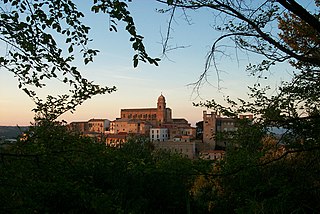
Miglianico a town and comune of the province of Chieti in the Abruzzo region of Italy.

San Salvo is a comune and town in the Province of Chieti in the Abruzzo region of Italy. It is the last Abruzzo town on the Adriatic coast before entering the Molise Region.
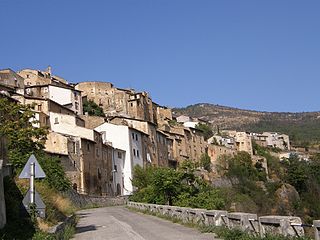
Acciano is a comune in the Province of L'Aquila in the Abruzzo region of Italy. The small, medieval village is in the Subequana valley and is a part of the Sirentina Mountain Community.

Loreto Aprutino is a comune and town in the Province of Pescara in the Abruzzo region of central Italy.

Corropoli is a town and comune in Teramo province in the Abruzzo region of eastern Italy. In recent years the town has had a population of just under 4000 individuals. The commune has approximately 1300 families and 1500 habitations. The gentilic for the town is Corropolesi. Corropoli takes its name from the word "Ripoli", an ancient neolithic settlement located nearby. These ruins were discovered by Concezio Rosa, a physician from Corropoli, in 1871. The patron saint of Corropoli is Saint Agnes. The commune has a density of approximately 170 individuals per square kilometer. The zip code for the town is 64013 and the phone prefix is 0861.
Orta Nova is a town and comune about 25.4 kilometres (15.8 mi) from Foggia, in the region of Apulia, in southern Italy. It stretches to the southern part of the Tavoliere on the right bank of the River Carapelle.

A rocca is a type of Italian fortified stronghold or fortress, typically located on a hilltop, beneath or on which the inhabitants of a historically clustered village or town might take refuge at times of trouble. Generally under its owners' patronage, the settlement might hope to find prosperity in better times. A rocca might in reality be no grander than a fortified farmhouse. A more extensive rocca would be referred to as a castello.

Villa Magna is a large ancient imperial Roman villa near the modern town of Anagni, in Lazio, central Italy. The site lies in the Valle del Sacco some 65 km south of Rome, at the foot of the Monti Lepini, directly under the peak known as Monte Giuliano. The toponym 'Villamagna' remains attached to the site, attesting to the local memory of the imperial villa and its successive occupation as a monastery and lay community.

Abruzzo is an Italian wine region located in the mountainous central Italian region of Abruzzo along the Adriatic Sea. It is bordered by the Molise wine region to the south, Marche to the north and Lazio to the west. Abruzzo's rugged terrain, 65% of which is mountainous, help to isolate the region from the winemaking influence of the ancient Romans and Etruscans in Tuscany but the area has had a long history of wine production.




















